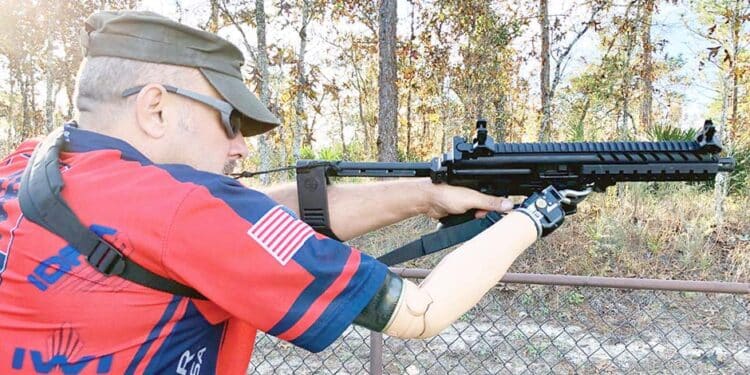By Rick Cicero
On August 4, 2010, my life and shooting changed forever with the loss of my arm and leg in Afghanistan. During my recovery, shooting has always been a huge benefit physically and personally. Even as my pistol work improved and I learned to shoot a rifle from a bench, standing and shooting a long gun remained elusive. In early 2013, an associate from the VA introduced me to a fellow veteran who had a “great idea” for guys just like me.

SIG SAUER Brace
Alex was the creator of the Brace; when I first picked it up my life changed. What is now the “SIG Brace” was attached to a 5.56 AR pistol. As I strapped it on and dry fired for the first time, it was like taking my first steps again! When the first few rounds left the barrel I knew this was the start of something great.
Since it was new and I was the first one-armed guy to use it, I had to find the best way to approach the grip, stance, sighting (positions and systems) and balance. Work at this I did, and before I realized it, I was building the skills I could later use to shoot a long gun standing again.

With my stance slightly bladed, the pistol slightly canted, adding a sling made it an accurate tool with one hand out to 100 yards repeatedly. Surprisingly the best sighting systems were either simple iron sights or a low-profile optic like the SIG SAUER Romeo 4. After experimenting with offsets and other options, it seemed they never had the consistency and accuracy of those basics. As with all sight-ing options it has to be natural; by holding the pistol at a 20-30 degree cant, the consistency was achieved.
As the Brace popularity grew from the first AR pistols, other manufacturers began outfitting a variety of platforms. The offerings of different calibers and size systems improved my skills at every turn. Products like the SIG SAU-ER MPX, Kris Vector, IWI micro UZI CZ Scorpion and Quarter Circle 10 9mm platforms are options for those with less upper body strength.
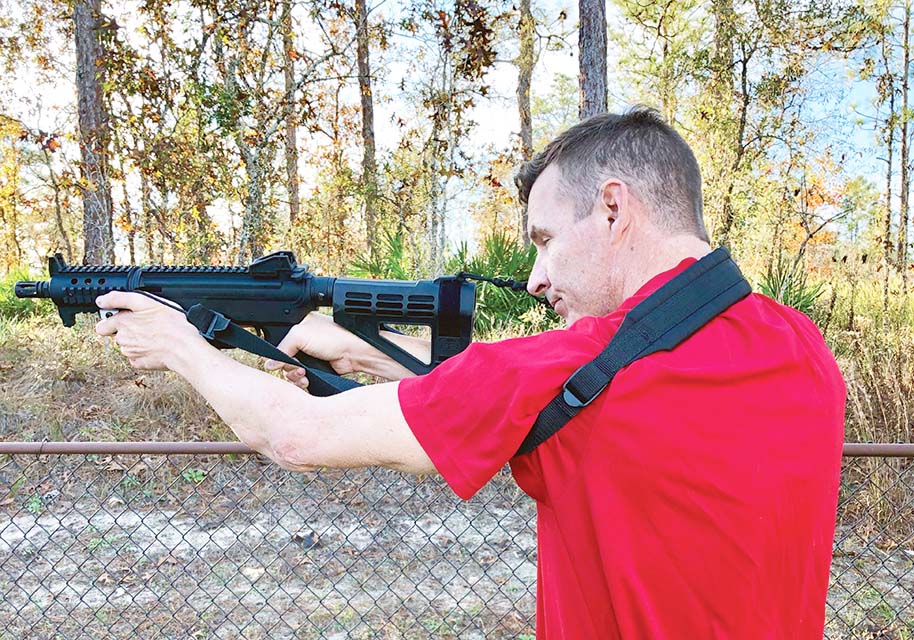
As with any instructional tool, having options is a huge benefit. These products provided variety in size, weight, balance and sight plane to give injured shooters the best tools possible. As the shooters’ skills improve, they can advance to the next level and calibers including 5.56, .300BO and even 7.62×39. But back then, there was still a resource missing—a .22LR.
Filling the Gap
With another great teammate we found just the platform at Mossberg. They produce a .22 pistol and a .22 rifle which both resemble an AR. As a joint effort, we fashioned a buffer tube from the rifle to accept the brace. This one of a kind pistol has become a fantastic tool for helping to develop the strength and skills in partial Quadriplegic and Paraplegic veteran students to use pistols and rifles independently.
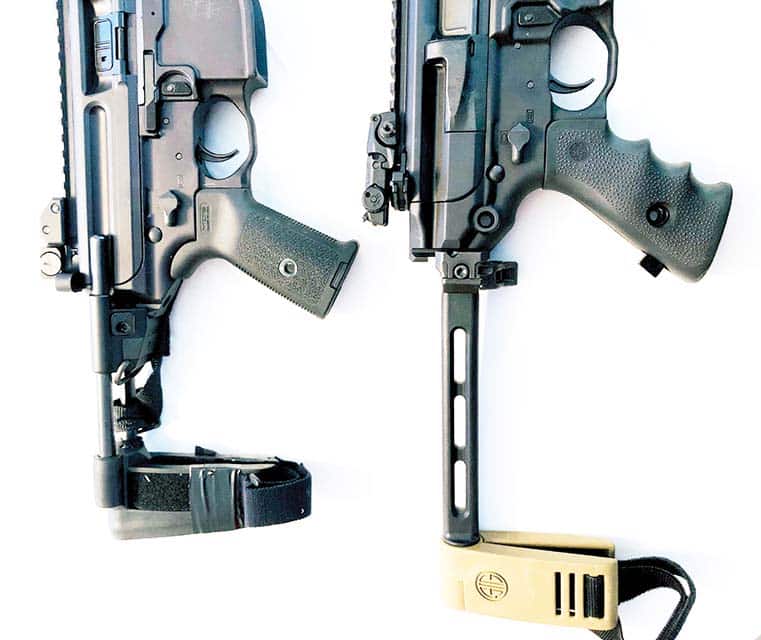
The magic begins once we are able to put our students in a comfortable stance and manipulate their arms up into a shooting position without a firearm. Once they can demonstrate the strength and dexterity, we place the pistol in their hand to have them raise the pistol to the shooting position without employing the brace. This provides them the ability to find the sights independently and feel the brace on their forearm.
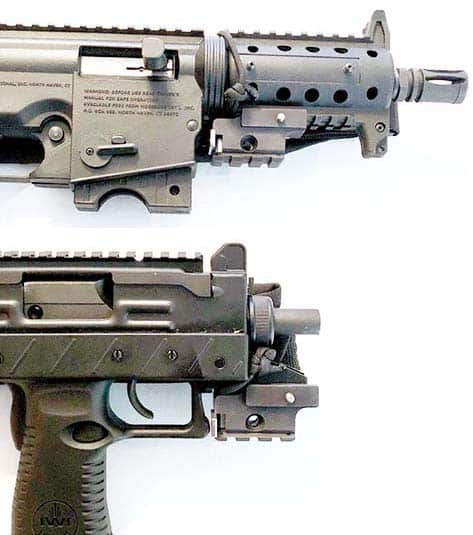
Learning to Shoot Again
For the one-armed shooter without a sling, the strong arm is extended straight out so the brace falls naturally on the forearm, and the sights fall into the line of sight. If the shooter has a functioning support arm, that hand or prosthetic is placed on the magazine well. The support arm is extended straight out, and the pistol is pushed into it for the start of a consistent stable platform.
Next, we employ a two-point sling to push against and create more points of contact for stability. This also naturally brings the brace in place on the shooter’s forearm. The sling is attached to the top of the brace at the rear and forward of the magazine well on the pistol. The sling is routed over the shooter’s strong shoulder, across the back and under the support arm. The support arm position remains the same and sets the stopping point for the sling. For those without a support arm, the sling is adjusted to a length according to whether the shooter has a support arm. This puts a flex in the strong elbow for more strength; the sling gives him the stability he would be missing otherwise. The strong elbow is flexed down for comfort and endurance. After repeated dry fire repetitions, adjust the brace to the shooter’s forearm.
The brace is adjusted to be snug at the strap but not tight when the shooter is in position. With the brace and sling adjust-ed, we now have five points of contact for the shooter with two arms and four for the shooter with one hand. These points of contact are the forward and rear sling points, the pistol grip, the brace and the shoulders. Now we are ready for the first shots. As with every other platform, we progress with distance, drills and caliber. I have and will always enjoy the freedom and accuracy the brace gives me out to 100 yards.
New Designs
Over the years, the brace has evolved in several different designs, including an adjustable version. The most recent design from SIG SAU-ER offers every advancement I have sought over the years. This version offers a lower profile attachment from the traditional buffer tube, a slim yet very stable brace, a swivel mount and the ability to fold it along side of the pistol. This brace is designed for the SIG MPX, MCX and Rattler Pistols at this time.
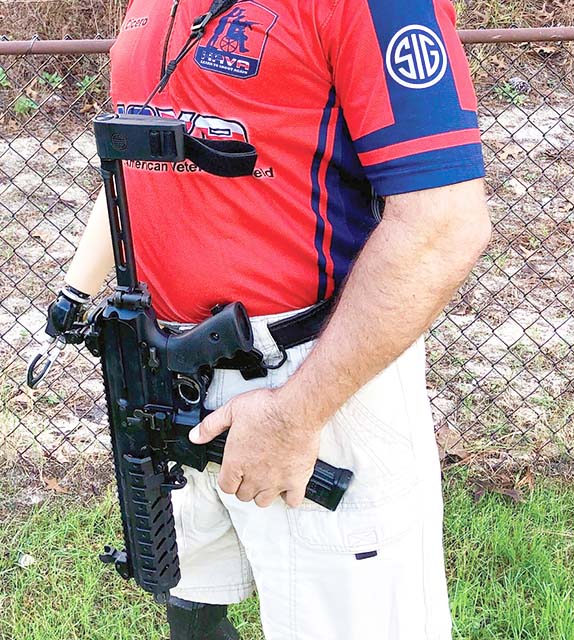
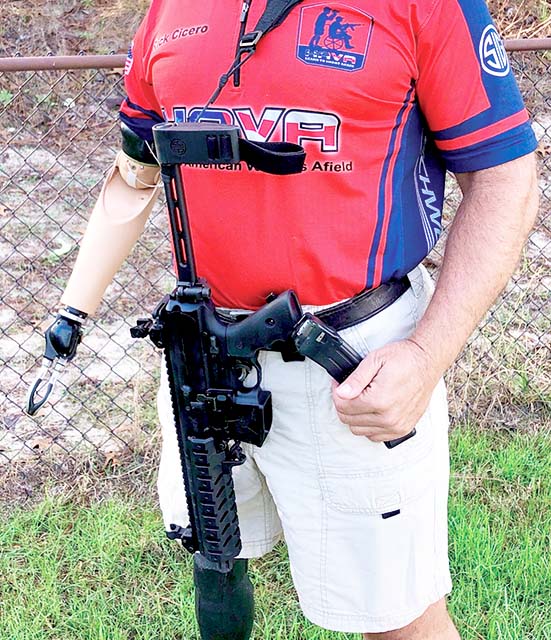
The flexibility of these platforms suits a great many students regardless of their physical challenges. The addition of the variety of braces, sighting options, slings and the addition of a Quick Clip create many options for our students. The Quick Clip provides shooters (especially the one-armed shooter) with a stable point to improve loading, movement and malfunction clearing. The options for mounting are either the front rail or pistol grip, without impairing the shooter or the operation of the pistol. The attachment affixes to a pin mounted on either the belt or a vest to secure it to the shooter and is released with the press of a button.
These drills and options have now established a foundation/stance, strength, grip, trigger control, sighting skills and balance for our shooters. Once the shooters have mastered the pistol caliber braced guns, they are ready for a traditional pistol. Using these same fundamentals, the shooters can apply them with the same approach to learning new pistol skills. Later we return to the rifle calibers to prepare our students for a traditional rifle. We employ the sling in the very same fashion and establish a “Cheek Weld” position which is directly in line with the braced approach.
Training Success
The training evolution the brace brings for me and our students brings continuity to braced guns, traditional pistols, rifles and shotguns throughout training. The SIG Brace continues to bring me and our students this success.
| This article first appeared in Small Arms Review V23N6 (JUNE/JULY 2019) |



